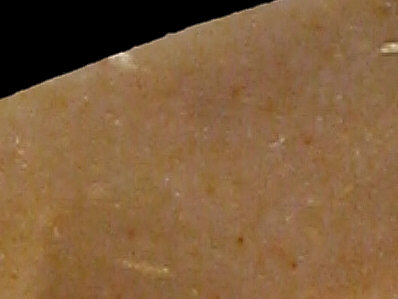
Foto: Jehanne Féblot-Augustins, 2005.
- Les Côtes
Sampled sites:
| Material name: | CC4b |
| Synonyms: | Silex Crétacé supérieur Centre - Sénonien. |
| Material (geologic): | Late Cretaceous (Senonian) flint. |

Foto: Jehanne Féblot-Augustins, 2005. |
Sampled sites:
|
| Mode of occurrence: | Small regular nodules. |
| Cortex: | Worn, thin, light brown, smooth, transition sharp. |
| Colour: | Brown (10YR 5/3). |
| Pattern: | Featureless. |
| Appearance: | Reasonably homogeneous material with a dull lustre, opaque, smooth, very medium-grained. |
| Structure: | No particular structure. |
| Texture: | Wackestone, with a packstone band below the cortex. |
| Matrix: | Opaque. |
| Grains: | 15-20 to 35 %, yellow to orangey yellow, rounded with high sphericity or irregularly shaped (mean size 150 µ). |
| Grain composition: | Sponge spicules, bryozoan fragments, planispiral foraminifera, several acritarchs (80 µ); rare iron oxides and detrital quartz. |
| Further information: | Click here for the original French description (opens in a new window), or here for more information on the attributes used in the description (use your browser's "BACK"-button to return here). |
| Citing: | Information on citing this page can be found here. |
| Locality: | Andert-et-Condon / Andert - Les Côtes, France, Ain department |
| Synonyms: | Sampling site Bugey 52 after Féblot-Augustins |
| Geographical description: | N/A |
| Geographical co-ordinates: |
east/x 858,4 north/y 2092,2 (Lambert zone II, NTF)
This corresponds roughly with |
| Co-ordinate precision: |
The coordinates given were taken from a large-scale map, and won't be off by more than 50 metres. The latitude/longitude coordinates are a direct transformation of these data on WGS84 and are accurate to the same level, so give or take an arc-second or two. The location can be found on the 1:25 000 topographical map sheet 3231 E of the French Institut Géographique National. |
| Geology: |
According to the geological map, the substrate is of Oligocene age (unit 'g'). The flint istself originates in Late Cretaceous (Senonian) sediments and lies here in a secondary position. Map of all sampled localities of Late Cretaceous flint in the Bugey (PDF, 54 KB, opens in new window). |
| Type of source: | Secondary. |
| Other types of flint: | Apart from the CC4b flint, quite a lot of other Late Cretaceous (Senonian) flints can be found here, CC2, CC3a, CC3b, CC4a as well as Early Cretaceous (Urgonian) material of the Ur-type |
thumb.jpg) Foto: Jehanne Féblot-Augustins, 2005 |
thumb.jpg) Foto: Jehanne Féblot-Augustins, 2005 |
| Last modified on: November 15, 2005 |
Contents primarily by: Jehanne Féblot-Augustins |
Comments to: |